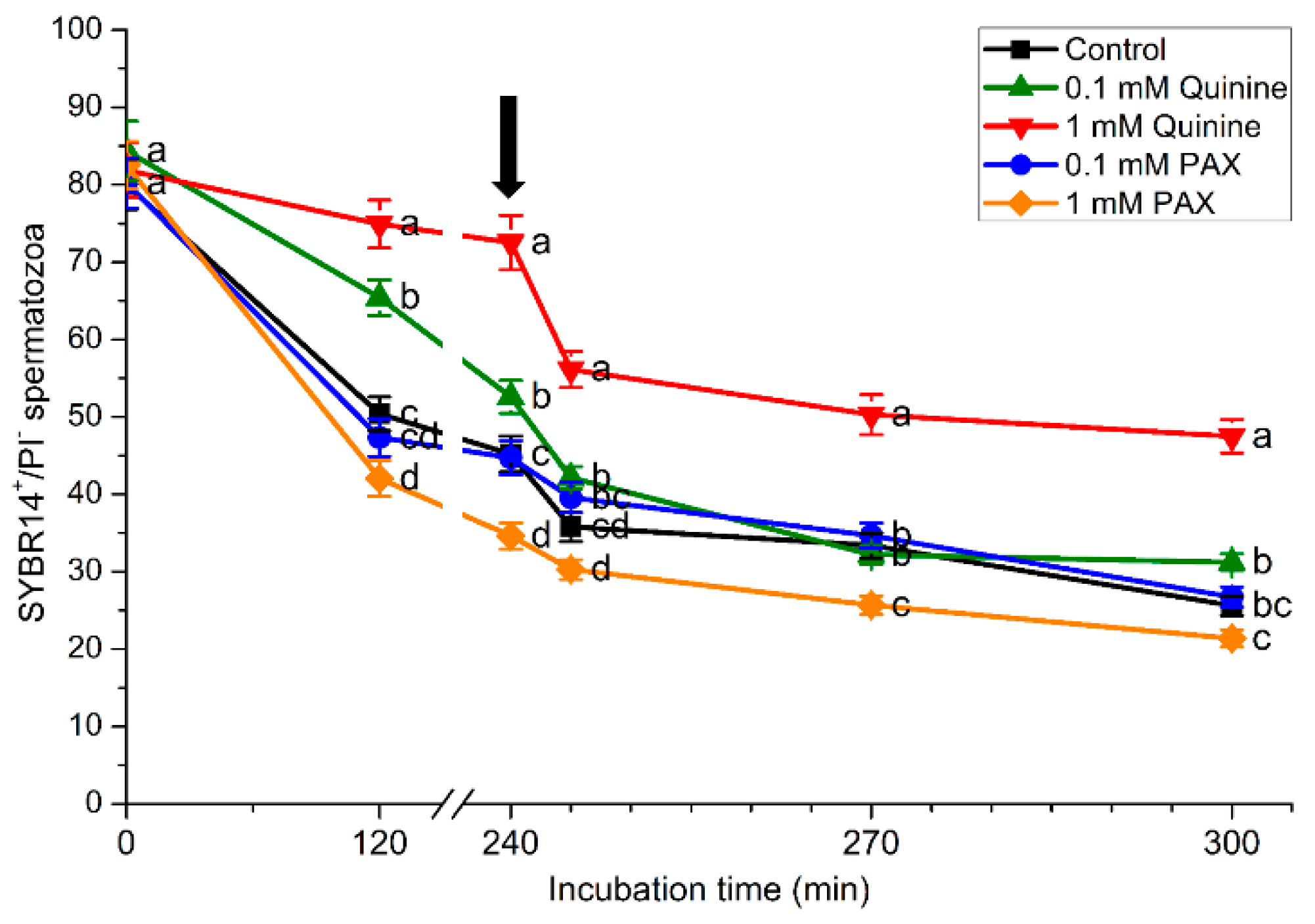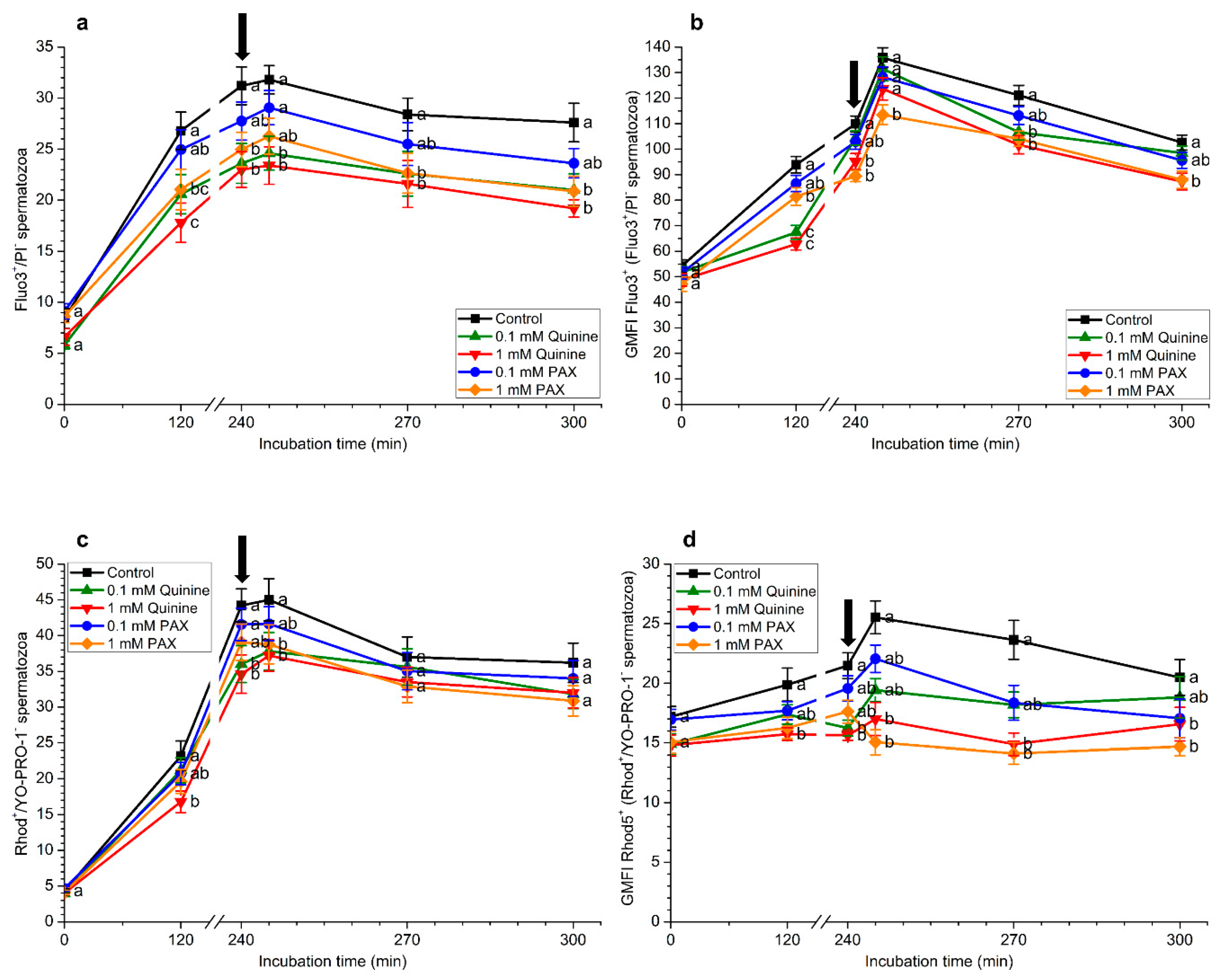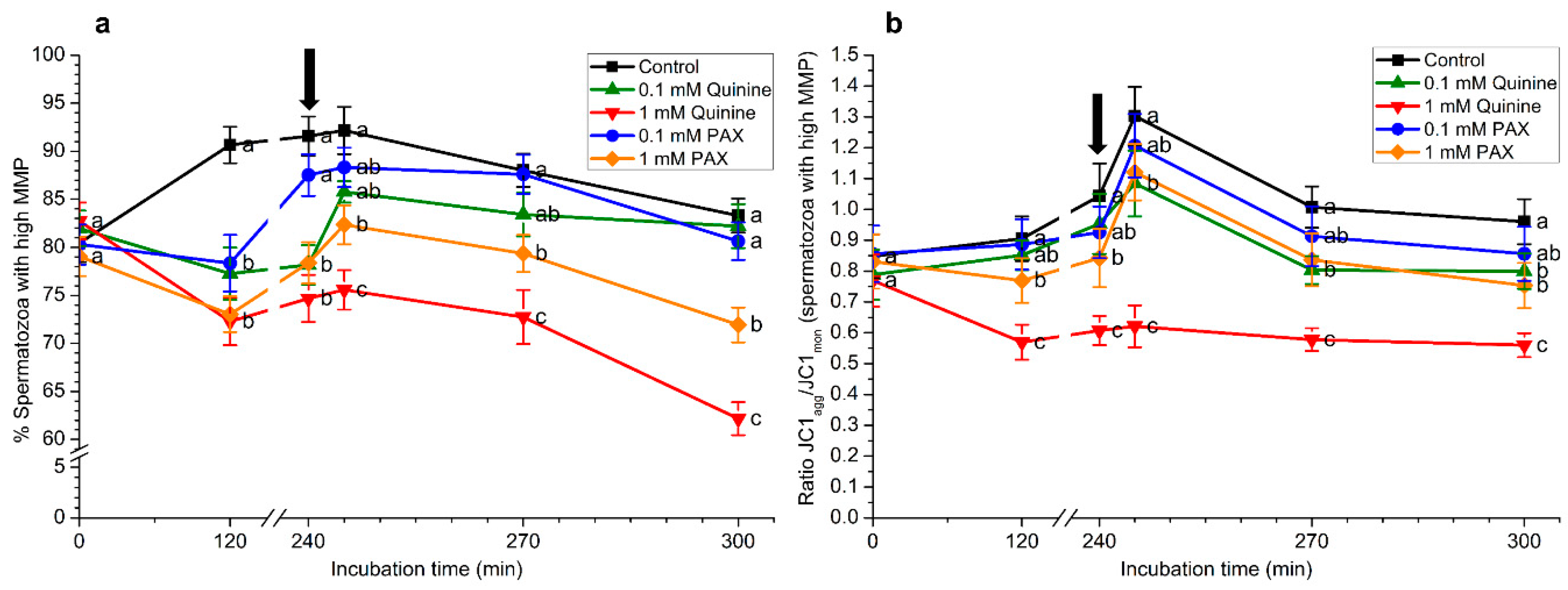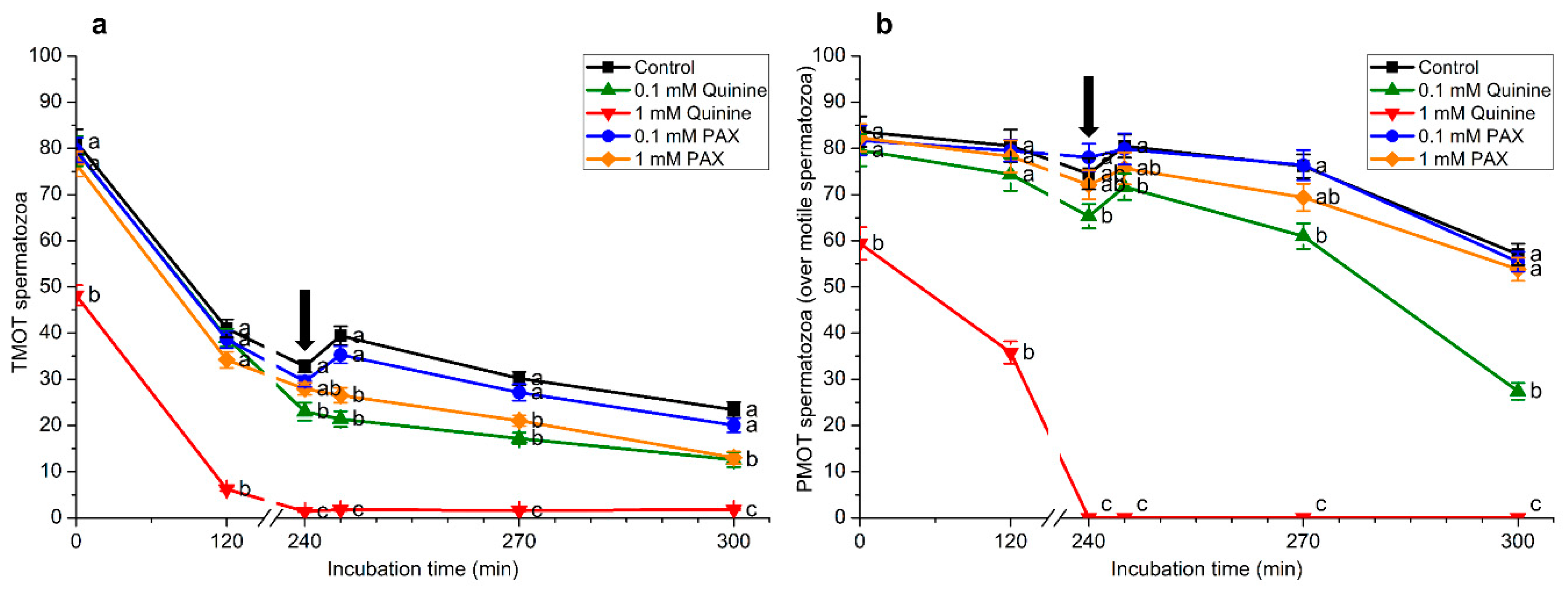Inhibition of Potassium Channels Affects the Ability of Pig Spermatozoa to Elicit Capacitation and Trigger the Acrosome Exocytosis Induced by Progesterone
Abstract
1. Introduction
2. Results
2.1. Effects of Quinine and Paxilline on Plasma Membrane Integrity
2.2. Effects of Quinine and Paxilline on Acrosome Integrity
2.3. Effects of Quinine and Paxilline on Membrane Lipid Disorder
2.4. Effects of Quinine and Paxilline on Intracellular Calcium Levels
2.5. Effects of Quinine and Paxilline on Mitochondrial Membrane Potential
2.6. Effects of Quinine and Paxilline on Sperm Motility
3. Discussion
4. Materials and Methods
4.1. Reagents
4.2. Semen Samples
4.3. In Vitro Sperm Capacitation
4.4. Inhibition of Calcium-Activated Potassium Channels with Quinine and Paxilline
4.5. Flow Cytometry Analyses
4.5.1. Plasma Membrane Integrity
4.5.2. Acrosome Integrity
4.5.3. Membrane Lipid Disorder
4.5.4. Intracellular Calcium Levels
4.5.5. Mitochondrial Membrane Potential
4.6. Analysis of Sperm Motility
4.7. Statistical Analyses
5. Conclusions
Supplementary Materials
Author Contributions
Funding
Institutional Review Board Statement
Informed Consent Statement
Data Availability Statement
Conflicts of Interest
Abbreviations
| ALH | Amplitude of Lateral Head Displacement |
| BCF | Beat Cross Frequency |
| BSA | Bovine Serum Albumin |
| CASA | Computer-Assisted Sperm Analysis |
| CFTR | Cystic Fibrosis Transmembran Conductance Regulator |
| CM | Capacitating Medium |
| DANCE | Forward Movement of the Head |
| EV | Electronic Volume |
| FITC | Fluorescein Isothiocyanate |
| FSC | Forward Scatter |
| GSK3a | Glycogen Synthase Kinase-3 isoform α |
| GSK3ß | Glycogen Synthase Kinase-3 isoform β |
| ISAC | International Society for Advancement of Cytometry |
| ISAS | Integrated Sperm Analysis System |
| JC1 | 5,5′,6,6′-tetrachloro-1,1′,3,3′tetraethylbenzimidazolylcarbocyanine iodide |
| LIN | Linearity |
| M540 | Merocyanine-540 |
| MAD | Mean Angular Displacement |
| MMP | Mithocondrial membrane potential |
| PCA | Principal Component Analysis |
| PI | Propidium Iodide |
| PMOT | Progressive Motility |
| PNA | Peanut Agglutinin |
| SEM | Standard Error of the Mean |
| SP | Motile subpopulation |
| SRF | Sperm-Rich Fraction |
| SSC | Side Scatter |
| STR | Straightness |
| TMOT | Total Motility |
| VAP | Average Path Velocity |
| VCL | Curvilinear Velocity |
| VSL | Straight Linear Velocity |
| WOB | Wobble Coefficient |
References
- Salicioni, A.M.; Platt, M.D.; Wertheimer, E.V.; Arcelay, E.; Allaire, A.; Sosnik, J.; Visconti, P.E. Signalling pathways involved in sperm capacitation. Soc. Reprod. Fertil. Suppl. 2007, 65, 245–259. [Google Scholar] [PubMed]
- Santi, C.M.; Orta, G.; Salkoff, L.; Visconti, P.E.; Darszon, A.; Treviño, C.L. K+ and Cl− channels and transporters in sperm function. Curr. Top. Dev. Biol. 2013, 102, 385–421. [Google Scholar] [CrossRef]
- Visconti, P.E.; Krapf, D.; De La Vega-Beltrán, J.L.; Acevedo, J.J.; Darszon, A. Ion channels, phosphorylation and mammalian sperm capacitation. Asian J. Androl. 2011, 13, 395–405. [Google Scholar] [CrossRef] [PubMed]
- Yeste, M.; Llavanera, M.; Pérez, G.; Scornik, F.; Puig-Parri, J.; Brugada, R.; Bonet, S.; Pinart, E. Elucidating the role of K+ channels during in vitro capacitation of boar spermatozoa: Do SLO1 channels play a crucial role? Int. J. Mol. Sci 2019, 20, 6330. [Google Scholar] [CrossRef]
- Yeste, M.; Llavanera, M.; Mateo-Otero, Y.; Catalán, J.; Bonet, S.; Pinart, E. HVCN1 Channels Are Relevant for the Maintenance of Sperm Motility During In Vitro Capacitation of Pig Spermatozoa. Int. J. Mol. Sci 2020, 21, 3255. [Google Scholar] [CrossRef] [PubMed]
- Darszon, A.; Labarca, P.; Nishigaki, T.; Espinosa, F. Ion channels in sperm physiology. Physiol. Rev. 1999, 79, 481–510. [Google Scholar] [CrossRef]
- Lishko, P.V.; Kirichok, Y.; Ren, D.; Navarro, B.; Chung, J.J.; Clapham, D.E. The control of male fertility by spermatozoan ion channels. Annu. Rev. Physiol. 2012, 74, 453–475. [Google Scholar] [CrossRef]
- Brown, S.G.; Publicover, S.J.; Barratt, C.L.R.; Martins da Silva, S.J. Human sperm ion channel (dys)function: Implications for fertilization. Hum. Reprod. Update 2019, 25, 758–776. [Google Scholar] [CrossRef]
- Vyklicka, L.; Lishko, P.V. Dissecting the signaling pathways involved in the function of sperm flagellum. Curr. Opin. Cell Biol. 2020, 63, 154–161. [Google Scholar] [CrossRef]
- Lang, F.; Busch, G.L.; Ritter, M.; Völkl, H.; Waldegger, S.; Gulbins, E.; Häussinger, D. Functional significance of cell volume regulatory mechanisms. Physiol. Rev. 1998, 78, 247–306. [Google Scholar] [CrossRef]
- Yeung, C.H.; Anapolski, M.; Depenbusch, M.; Zitzmann, M.; Cooper, T. Human sperm volume regulation. Response to physiological changes in osmolality, channel blockers and potential sperm osmolytes. Hum. Reprod. 2003, 18, 1029–1036. [Google Scholar] [CrossRef] [PubMed]
- Darszon, A.; Nishigaki, T.; Beltran, C.; Treviño, C.L. Calcium channels in the development, maturation, and function of spermatozoa. Physiol. Rev. 2011, 91, 1305–1355. [Google Scholar] [CrossRef] [PubMed]
- Grizel, A.V.; Glukhov, G.S.; Sokolova, O.S. Mechanisms of activation of voltage-gated potassium channels. Acta Nat. 2014, 6, 10–26. [Google Scholar] [CrossRef]
- Schreiber, M.; Wei, A.; Yuan, A.; Gaut, J.; Saito, M.; Salkoff, L. Slo3, a novel pH-sensitive K+ channel from mammalian spermatocytes. J. Biol. Chem. 1998, 273, 3509–3516. [Google Scholar] [CrossRef]
- Miller, M.R.; Mansell, S.A.; Meyers, S.A.; Lishko, P.V. Flagellar ion channels of sperm: Similarities and differences between species. Cell Calcium 2015, 58, 105–113. [Google Scholar] [CrossRef] [PubMed]
- De La Vega-Beltran, J.L.; Sánchez-Cárdenas, C.; Krapf, D.; Hernandez-González, E.O.; Wertheimer, E.; Treviño, C.L.; Visconti, P.E.; Darszon, A. Mouse sperm membrane potential hyperpolarization is necessary and sufficient to prepare sperm for the acrosome reaction. J. Biol. Chem. 2012, 287, 44384–44393. [Google Scholar] [CrossRef]
- Santi, C.M.; Martínez-López, P.; De La Vega-Beltrán, J.L.; Butler, A.; Alisio, A.; Darszon, A.; Salkoff, L. The SLO3 sperm-specific potassium channel plays a vital role in male fertility. Febs Lett. 2010, 584, 1041–1046. [Google Scholar] [CrossRef]
- Zeng, X.H.; Yang, C.; Kim, S.T.; Lingle, C.J.; Xia, X.M. Deletion of the Slo3 gene abolishes alkalization activated K+ current in mouse spermatozoa. Proc. Nat. Acad. Sci. USA 2011, 108, 5879–5884. [Google Scholar] [CrossRef]
- Brenker, C.; Zhou, Y.; Müller, A.; Echeverry, F.A.; Trötschel, C.; Poetsch, A.; Xia, X.M.; Bönigk, W.; Lingle, C.J.; Kaupp, U.B.; et al. The Ca2+-activated K+ current of human sperm is mediated by Slo3. ELife 2014, 2014. [Google Scholar] [CrossRef]
- Mannowetz, N.; Naidoo, N.M.; Choo, S.A.S.; Smith, J.F.; Lishko, P.V. Slo1 is the principal potassium channel of human spermatozoa. ELife 2013, 2013. [Google Scholar] [CrossRef]
- Visconti, P.E. Understanding the molecular basis of sperm capacitation through kinase design. Proc. Nat. Acad. Sci. USA 2009, 106, 667–668. [Google Scholar] [CrossRef] [PubMed]
- Yeste, M. Boar spermatozoa within the oviductal environment (II): Sperm capacitation. In Boar Reproduction: Fundamentals and New Biotechnological Trends; Springer: Berlin/Heidelberg, Germany, 2013; Volume 9783642350, pp. 347–405. [Google Scholar] [CrossRef]
- Zigo, M.; Maňásková-Postlerová, P.; Zuidema, D.; Kerns, K.; Jonáková, V.; Tumová, L.; Bubenìcková, F.; Sutovsky, P. Porcine model for the study of sperm capacitation, fertilization and male fertility. Cell Tissue Res. 2020, 380, 237–262. [Google Scholar] [CrossRef]
- Bernabò, N.; Pistilli, M.G.; Mattioli, M.; Barboni, B. Role of TRPV1 channels in boar spermatozoa acquisition of fertilizing ability. Mol. Cell Endocrinol. 2010, 323, 224–231. [Google Scholar] [CrossRef] [PubMed]
- Vicente-Carrillo, A.; Álvarez-Rodríguez, M.; Rodríguez-Martínez, H. The CatSper channel modulates boar sperm motility during capacitation. Reprod. Biol. 2017, 17, 69–78. [Google Scholar] [CrossRef] [PubMed]
- Uzor, P.F. Alkaloids from plants with antimalarial activity: A review of recent studies. Evid. Based Complementary Altern. Med. 2020, 2020. [Google Scholar] [CrossRef]
- Grinstein, S. Ionic mechanisms of cell volume regulation in leukocytes. Annu. Rev. Physiol. 1990, 52, 399–414. [Google Scholar] [CrossRef]
- Kuriyama, H.; Kitamura, K.; Nabata, H. Pharmacological and physiological significance of ion channels and factors that modulate them in vascular tissues. Pharm. Rev. 1995, 47, 387–573. [Google Scholar] [PubMed]
- Petrunkina, A.M.; Harrison, R.A.P.; Hebel, M.; Weitze, K.F.; Töpfer-Petersen, E. Role of quinine-sensitive ion channels in volume regulation in boar and bull spermatozoa. Reproduction 2001, 122, 327–336. [Google Scholar] [CrossRef]
- Yeung, C.H.; Cooper, T. Effects of the ion-channel blocker quinine on human sperm volume, kinematics and mucus penetration, and the involvement of potassium channels. Mol. Hum. Reprod. 2001, 7, 819–828. [Google Scholar] [CrossRef]
- Chávez, J.C.; Ferreira, J.J.; Butler, A.; De La Vega Beltrán, J.L.; Treviño, C.L.; Darszon, A.; Salkoff, L.; Santi, C.M. SLO3 K+ channels control calcium entry through CATSPER channels in sperm. J. Biol. Chem. 2014, 289, 32266–32275. [Google Scholar] [CrossRef]
- Sanchez, M.; McManus, O.B. Paxilline inhibition of the alpha-subunit of the high-conductance calcium-activated potassium channel. Neuropharmacology 1996, 35, 963–968. [Google Scholar] [CrossRef]
- Wulff, H.; Zhorov, B.S. K+ channel modulators for the treatment of neurological disorders and autoimmune diseases. Chem. Rev. 2008, 108, 1744–1773. [Google Scholar] [CrossRef] [PubMed]
- Mancilla, E.; Rojas, E. Quinine blocks the high conductance, calcium-activated potassium channel in rat pancreatic beta-cells. Febs Lett. 1990, 260, 105–108. [Google Scholar] [CrossRef]
- Mathie, A.; Veale, E.L. Therapeutic potential of neuronal two-pore domain potassium-channel modulators. Curr. Opin. Invest. Drugs 2007, 8, 555–562. [Google Scholar]
- Aldakkak, M.; Stowe, D.F.; Cheng, Q.; Kwok, W.M.; Camara, A.K. Mitochondrial matrix K+ flux independent of large-conductance Ca2+-activated K+ channel opening. Am. J. Physiol. Cell Physiol. 2010, 298, C530–C541. [Google Scholar] [CrossRef] [PubMed]
- Lechniak, D.; Kedzierski, A.; Stanislawski, D. The use of HOS test to evaluate membrane functionality of boar sperm capacitated in vitro. Reprod. Domest. Anim. 2002, 37, 379–380. [Google Scholar] [CrossRef] [PubMed]
- Birck, A.; Labouriau, R.; Christensen, P. Dynamics of the induced acrosome reaction in boar sperm evaluated by flow cytometry. Anim. Reprod. Sci. 2009, 115, 124–136. [Google Scholar] [CrossRef]
- Bailey, J.L. Factors regulating sperm capacitation. Syst. Biol. Reprod. Med. 2010, 56, 334–348. [Google Scholar] [CrossRef]
- Harrison, R.A.P.; Gadella, B.M. Bicarbonate-induced membrane processing in sperm capacitation. Theriogenology 2005, 63, 342–351. [Google Scholar] [CrossRef]
- Flesch, F.M.; Brouwers, J.F.; Nievelstein, P.F.E.M.; Verkleij, A.J.; Van Golde, L.M.G.; Colenbrander, B.; Gadella, B.M. Bicarbonate stimulated phospholipid scrambling induces cholesterol redistribution and enables cholestrol depletion in the sperm plasma membrane. J. Cell. Sci. 2001, 114, 3543–3555. [Google Scholar] [PubMed]
- Suarez, S.S.; Ho, H.C. Hyperactivated motility in sperm. Reprod. Domest. Anim. 2003, 38, 119–124. [Google Scholar] [CrossRef]
- Findlay, I.; Dunne, M.J.; Ullrich, S.; Wollheim, C.B.; Petersen, O.H. Quinine inhibits Ca2+-independent K+ channels whereas tetraethylammonium inhibits Ca2+-activated K+ channels in insulin-secreting cells. Febs Lett. 1985, 185, 4–8. [Google Scholar] [CrossRef]
- Publicover, S.; Harper, C.V.; Barratt, C. [Ca2+]i signalling in sperm—Making the most of what you’ve got. Nat. Cell Biol. 2007, 9, 235–242. [Google Scholar] [CrossRef] [PubMed]
- Correia, J.; Michelangeli, F.; Publicover, S. Regulation and roles of Ca2+ stores in human sperm. Reproduction 2015, 150, R65–R76. [Google Scholar] [CrossRef]
- Costello, S.; Michelangeli, F.; Nash, K.; Lefievre, L.; Morris, J.; Machado-Oliveira, G.; Barratt, C.; Kirkman-Brown, J.; Publicover, S. Ca2+-stores in sperm: Their identities and functions. Reproduction 2009, 138, 425–437. [Google Scholar] [CrossRef]
- Yeste, M.; Fernández-Novell, J.M.; Ramió-Lluch, L.; Estrada, E.; Rocha, L.G.; Cebrián-Pérez, J.A.; Muiño-Blanco, T.; Concha, I.I.; Ramírez, A.; Rodríguez-Gil, J.E. Intracellular calcium movements of boar spermatozoa during ‘in vitro’ capacitation and subsequent acrosome exocytosis follow a multiple-storage place, extracellular calcium-dependent model. Andrology 2015, 3, 729–747. [Google Scholar] [CrossRef] [PubMed]
- Wu, J.T.; Chiang, K.C.; Cheng, F.P. Expression of progesterone receptor(s) during capacitation and incidence of acrosome reaction induced by progesterone and zona proteins in boar spermatozoa. Anim. Reprod. Sci. 2006, 93, 34–45. [Google Scholar] [CrossRef]
- Mukai, C.; Okuno, M. Glycolysis plays a major role for adenosine triphosphate supplementation in mouse sperm flagellar movement. Biol. Reprod 2004, 71, 540–547. [Google Scholar] [CrossRef]
- Piomboni, P.; Focarelli, R.; Stendardi, A.; Ferramosca, A.; Zara, V. The role of mitochondria in energy production for human sperm motility. Int. J. Androl. 2012, 35, 109–124. [Google Scholar] [CrossRef] [PubMed]
- Agnihotri, S.K.; Agrawal, A.K.; Hakim, B.A.; Vishwakarma, A.L.; Narender, T.; Sachan, R.; Sachdev, M. Mitochondrial membrane potential (MMP) regulates sperm motility. In Vitro Cell Dev. Biol. Anim. 2016, 52, 953–960. [Google Scholar] [CrossRef] [PubMed]
- Paventi, G.; Lessard, C.; Bailey, J.L.; Passarella, S. In boar sperm capacitation L-lactate and succinate, but not pyruvate and citrate, contribute to the mitochondrial membrane potential increase as monitored via safranine O fluorescence. Biochem. Biophys. Res. Commun. 2015, 462, 257–262. [Google Scholar] [CrossRef]
- Ramió-Lluch, L.; Fernández-Novell, J.M.; Peña, A.; Colás, C.; Cebrián-Pérez, J.A.; Muiño-Blanco, T.; Ramírez, A.; Concha, I.I.; Rigau, T.; Rodríguez-Gil, J.E. “In Vitro” capacitation and acrosome reaction are concomitant with specific changes in mitochondrial activity in boar sperm: Evidence for a nucleated mitochondrial activation and for the existence of a capacitation-sensitive subpopulational structure. Reprod. Domest. Anim. 2011, 46, 664–673. [Google Scholar] [CrossRef]
- Bednarczyk, P.; Kicińska, A.; Kominkova, V.; Ondrias, K.; Dolowy, K.; Szewczyk, A. Quinine inhibits mitochondrial ATP-regulated potassium channel from bovine heart. J. Membr. Biol. 2004, 199, 63–72. [Google Scholar] [CrossRef]
- Rocco, M.; Betarelli, R.; Placci, A.; Fernández-Novell, J.M.; Spinaci, M.; Casao, A.; Muiño-Blanco, T.; Cebrián-Pérez, J.A.; Peña, A.; Rigau, T.; et al. Melatonin affects the motility and adhesiveness of in vitro capacitated boar spermatozoa via a mechanism that does not depend on intracellular ROS levels. Andrology 2018, 6, 720–736. [Google Scholar] [CrossRef]
- Yeung, C.H.; Anapolski, M.; Sipilä, P.; Wagenfeld, A.; Poutanen, M.; Huhtaniemi, I.; Nieschlag, E.; Cooper, T.G. Sperm volume regulation: Maturational changes in fertile and infertile transgenic mice and association with kinematics and tail angulation. Biol. Reprod 2002, 67, 269–275. [Google Scholar] [CrossRef]
- Lee, J.A.; Spidlen, J.; Boyce, K.; Cai, J.; Crosbie, N.; Dalphin, M.; Furlong, J.; Gasparetto, M.; Goldberg, M.; Goralczyk, E.M.; et al. The minimum information about a flow cytometry experiment. Cytom. Part A 2008, 73, 926–930. [Google Scholar] [CrossRef]
- Yeste, M.; Codony, F.; Estrada, E.; Lleonart, M.; Balasch, S.; Peña, A.; Bonet, S.; Rodríguez-Gil, J.E. Specific LED-based red light photo-stimulation procedures improve overall sperm function and reproductive performance of boar ejaculates. Sci. Rep. 2016, 6, 22569. [Google Scholar] [CrossRef] [PubMed]
- Petrunkina, A.M.; Waberski, D.; Bollwein, H.; Sieme, H. Identifying non-sperm particles during flow cytometric physiological assessment: A simple approach. Theriogenology 2010, 73, 995–1000. [Google Scholar] [CrossRef] [PubMed]
- Cooper, T.G.; Yeung, C.H. A flow cytometric technique using peanut agglutinin for evaluating acrosomal loss from human spermatozoa. J. Androl. 1998, 19, 542–550. [Google Scholar] [PubMed]
- Harrison, R.A.P.; Ashworth, P.J.; Miller, N.G.A. Bicarbonate/CO2, an effector of capacitation, induces a rapid and reversible change in the lipid architecture of boar sperm plasma membranes. Mol. Reprod. Dev. 1996, 45, 378–391. [Google Scholar] [CrossRef]
- Harrison, R.A.P.; Mairet, B.; Miller, N.G.A. Flow cytometric studies of bicarbonate-mediated Ca2+ influx in boar sperm populations. Mol. Reprod. Dev. 1993, 35, 197–208. [Google Scholar] [CrossRef] [PubMed]
- Kadirvel, G.; Kumar, S.; Kumaresan, A.; Kathiravan, P. Capacitation status of fresh and frozen-thawed buffalo spermatozoa in relation to cholesterol level, membrane fluidity and intracellular calcium. Anim. Reprod. Sci. 2009, 116, 244–253. [Google Scholar] [CrossRef] [PubMed]
- Guthrie, H.D.; Welch, G.R. Determination of intracellular reactive oxygen species and high mitochondrial membrane potential in Percoll-treated viable boar sperm using fluorescence-activated flow cytometry. J. Anim. Sci. 2006, 84, 2089–2100. [Google Scholar] [CrossRef] [PubMed]





Publisher’s Note: MDPI stays neutral with regard to jurisdictional claims in published maps and institutional affiliations. |
© 2021 by the authors. Licensee MDPI, Basel, Switzerland. This article is an open access article distributed under the terms and conditions of the Creative Commons Attribution (CC BY) license (http://creativecommons.org/licenses/by/4.0/).
Share and Cite
Noto, F.; Recuero, S.; Valencia, J.; Saporito, B.; Robbe, D.; Bonet, S.; Carluccio, A.; Yeste, M. Inhibition of Potassium Channels Affects the Ability of Pig Spermatozoa to Elicit Capacitation and Trigger the Acrosome Exocytosis Induced by Progesterone. Int. J. Mol. Sci. 2021, 22, 1992. https://doi.org/10.3390/ijms22041992
Noto F, Recuero S, Valencia J, Saporito B, Robbe D, Bonet S, Carluccio A, Yeste M. Inhibition of Potassium Channels Affects the Ability of Pig Spermatozoa to Elicit Capacitation and Trigger the Acrosome Exocytosis Induced by Progesterone. International Journal of Molecular Sciences. 2021; 22(4):1992. https://doi.org/10.3390/ijms22041992
Chicago/Turabian StyleNoto, Federico, Sandra Recuero, Julián Valencia, Beatrice Saporito, Domenico Robbe, Sergi Bonet, Augusto Carluccio, and Marc Yeste. 2021. "Inhibition of Potassium Channels Affects the Ability of Pig Spermatozoa to Elicit Capacitation and Trigger the Acrosome Exocytosis Induced by Progesterone" International Journal of Molecular Sciences 22, no. 4: 1992. https://doi.org/10.3390/ijms22041992
APA StyleNoto, F., Recuero, S., Valencia, J., Saporito, B., Robbe, D., Bonet, S., Carluccio, A., & Yeste, M. (2021). Inhibition of Potassium Channels Affects the Ability of Pig Spermatozoa to Elicit Capacitation and Trigger the Acrosome Exocytosis Induced by Progesterone. International Journal of Molecular Sciences, 22(4), 1992. https://doi.org/10.3390/ijms22041992








